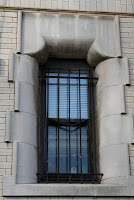“Contextual design emphasizes compatibility and works to respect the scale, height, setback, materials and detailing of surrounding older buildings. This does not mean that new designs need to look old – in most cases, this would be inappropriate. Rather, it means that contemporary design should blend with the old so that new and old are distinguishable but compatible. The sense of continuity and basic sensitivity to the old has been referred to as an “architectural genetic code”(1), a code of craftsmanship worked out over generations of trial and error.”(2)
A reader’s comment on a (January 12th, 2011) blog article in the Preservation Institute Blog about contextualism was spot on. David Sucher is quoted as saying said... “Contextualism is only of value when the context is valuable.” The blog dissected an article in the New York Times by Nicolai Ouroussoff discussing the philosophy of what is actually worth preserving.
Charles Siegel author of the Preservation Institute Blog writes: -
“When we were on the defensive because traditional urbanism was constantly being threatened by modernist projects, it made some sense to talk about design that respects its context. But now that we are beginning to transform inhuman modernist developments into good places for people to be, it is time to start talking about design that respects human nature. It is time to move from architectural contextualism to architectural humanism.”
Kurt Anderson’s writings from 1987, republished recently are well worth reading, for they bring a balanced perspective to the discussion about preservation and new construction. Times are demanding a little more common sense as well as common sensitivity. I have quoted liberally from Anderson’s work below.
“What has come to be known as gentrification -- the migration of (mainly white) middle-class homesteaders into poor (mainly black and Hispanic) urban neighborhoods -- is neither the cause nor an effect, exactly, of the historic renovation boom. But the two trends have abetted each other. The original '60s militants of the preservation movement were the shock troops of the upper middle class, and it was a broader swath of the same class who in the '70s made living amid urban antiquity seem both virtuous and stylish. Restored carriage houses and pressed-tin ceilings have seduced more children of the suburbs back to the city than mean, shiny apartment towers.”
Preservation can set up a self-destructive cycle. When a historic neighborhood is restored, it becomes desirable and prices go up, and when prices go up sufficiently, developers think dollars per square foot, high- rise, wrecking ball. They wind up selling the view of a historic district from a condominium tower that has supplanted a piece of that history.
Not every old building can be saved. Not every old building should be saved. Except for set pieces like fussy little Colonial Williamsburg or the elegant Upper East Side of Manhattan, cities should not remain stuck in time. As Charlestonians have learned, vitality depends on at least modest infusions of new building. Even preservationists, most of them, agree in principle. Says Gene Norman, chairman of New York City's Landmarks Preservation Commission: "We are not trying to create a museum city."
Yet the reflexive impulse to preserve everything, even the relatively new and banal, occasionally shows signs of getting out of hand. "People are just beginning to talk about ' '50s classics' now, which is a term that embraces some really appalling ticky-tack," says the British-born architectural historian Reyner Banham, who lives in California. "There is a tendency to overlook the aesthetic quality of a building and just keep it because it is old," says Robert Winter, a cultural historian at Occidental College in Los Angeles. "Too often the reason for declaring something ((a historic landmark)) is sentimental." Sentiment is inadmissible? Isn't the new feeling for preservation and for cities inherently romantic, clear-headedness clouded by a large dose of nostalgia?”
According to the D.C. Historic Preservation Office: -
“Planning and neighborhood protection. Historic designation is an important planning tool for the city, a way to improve the quality of life and a means to protect neighborhoods from unmanaged change.
Public participation. Because the review process involves public comment, citizens are given a voice in development affecting their neighborhoods.
Designing a new building that contributes to, rather than detracts from, the character of a historic district begins with an analysis of the character-defining features of the existing historic buildings, streets and landscapes. Typically, character-defining features include: setback. Orientation, scale, proportion, rhythm, massing, height, materials, color, roof shape and details and ornamentation.
A new building should be compatible with the existing environment without exactly duplicating existing buildings. A new building in a historic district must also conform to the District of Columbia’s zoning and building codes.
A new building should be seen as a product of its own time. To reproduce a historic building or to copy exactly a style from the past, creates a false sense of history. By relating to the existing buildings and the environment, but being of its own time, a new building shows a district’s evolution just as the existing buildings show its past. Perhaps the best way to think about a compatible new building is that it should be a good neighbor, enhancing the character of the district and respecting the context, rather than an exact clone.”
(2) Norman Tyler, “Historic Preservation” – an introduction to its history, principles and practice, W.W. Norton and Company, 2000 page 139



















